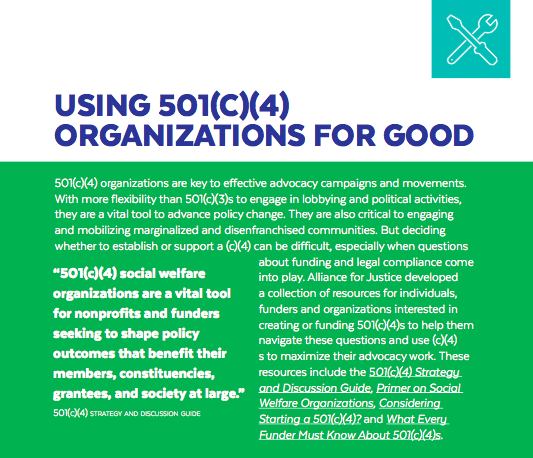501(c)(4) organizations are key to effective advocacy campaigns and movements. With more flexibility than 501(c)(3)s to engage in lobbying and political activities, they are a vital tool to advance policy change. They are also critical to engaging and mobilizing marginalized and disenfranchised communities. But deciding whether to establish or support a (c)(4) can be difficult, especially when questions about funding and legal compliance come into play. Alliance for Justice developed a collection of resources for individuals, funders and organizations interested in creating or funding 501(c)(4)s to help them navigate these questions. As well, earlier this year, they published an article in Philanthropy Journal about the urgency of funder support for maximum advocacy efforts.
PRimer on Social Welfare Organizations: using 501c4 Organizations for Good
501c4 organizations remain a vital tool for nonprofits and foundations seeking to shape policy outcomes that benefit constituencies and communities that too often go unheard. This publication explores the special role 501c4 groups can play within the nonprofit and philanthropic communities, and within our political system, and has been written to dispel myths and encourage their thoughtful use within the democratic process.
501c4 Strategy and Discussion Guide
This Strategy and Discussion Guide has been developed for individuals, organizations, and funders interested in starting 501(c)(4) organizations. It discusses the strategic questions that must be considered in determining whether, when, and for what purpose(s) to create a (c)(4).
Case Studies: COnsidering Starting a 501c4?
Deciding whether—or when—to establish a 501(c)(4) organization is never an easy decision. Questions about purpose, scope, funding, perception, timing, and legal compliance all come into play. There are few definitive “right” and “wrong” answers. Each group needs to determine what is right for it. These case studies describe how three different groups, with different structures, needs, and pressures, answered the questions for themselves.




